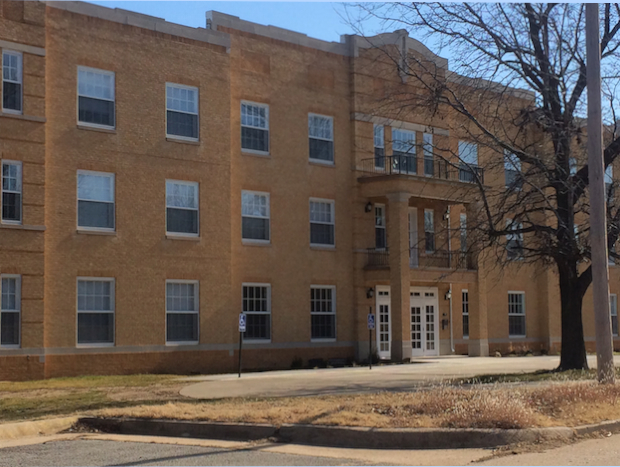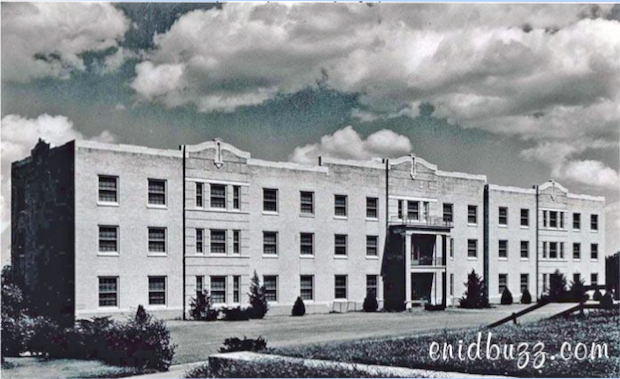Clay Hall (above 2014), Old Phillips University Female Dorm. This haunted dormitory was condemned by state in the early 1980`s. Voices have been heard here along with piano playing. Recordings of ghostly women singing have also occurred. (This building was placed on the list of historic places and then sold in 2012 to a company that refurbished the inside and it is now low income apartments for senior citizens.)
The first cemetery in Enid was started in 1897.
The cemetery was created out of necessity as new settlers had to bury their deceased but lacked an official cemetery. After the first person was buried it didn’t take long before another was buried nearby in the area and thus the precedent to use the area as a cemetery was well established. There were more than 200 people buried in the early day cemetery before many, but not all of them, were moved to our present day cemetery.
Years later when the old unofficial cemetery was developed as a housing addition construction workers reported striking old caskets while excavating for foundations for new homes. Many families were unable to afford the cost of moving their relatives to the new cemetery, thus several graves remained in the area even as the large homes were being built.
Where was this early day cemetery? It was located near the corner of South VanBuren and Wabash streets in what is now known as the Kisner Addition! SO, if you live in the area and you think you’ve heard ghosts in the attic . . . you just might be right.
The building at 303 W. Broadway just west of the downtown area is a five-story brick building which once housed the Masonic Temple on the fourth and fifth floors. It is currently the home of the Enid Symphony Orchestra, with rooms and banquet hall available for private events.
The Enid Buzz online newspaper relates the story of George, who has been seen and experienced in this building over the years. Their account reads as follows: "Of its six stories, the top two were built as a Masonic Temple, housing a large concert hall, banquet hall, and theatre, as well as ancillaries. At one time it was the largest and most active Masonic Temple in the region. It`s doors were abruptly closed in 1946 for reasons unknown. Between 1946 and 1981, no one was allowed onto the top two floors of the building. For years the owner refused to sell the building. Of the stories “The Lights,” are the best known around the city of Enid. The director of the Enid Symphony had an encounter with George the elevator repairman walking the halls."
From the website of P.P.I. Pananormal Investigations:
"The Knox Building was built in 1921 and was used as a Masonic Temple. The building was closed during the 1940s and sat vacant until some time in the 1980s, with the fourth and fifth floors remaining vacant until the 1990s.
Doug Newell, music director of Enid Symphony Orchestra, was more than willing to fill me in on the accounts from people who have had strange experiences in the building. First, Newell shared a personal experience.
“I heard someone come down the stairwell one day and I went to see who it was,” said Newell. As he reached the stairwell, Newell came upon a short man in a blue work suit with a cigar in his mouth. Newell offered up a kind hello, but the stranger never responded. He continued down the stairs, the sound of his footsteps disappearing the instant he did.
Remembering the name George on the monogram of the man’s blue work suit, Newell called the elevator company and thanked them for sending George to work on the elevator in the building. The answer Newell received was not, “You’re welcome.” The answer Newell received was the elevator company had not sent a repairman."
Legend has it George was once a worker in the building during the early days. He met his untimely death when he fell down an elevator shaft. There are many other accounts of footsteps, doors opening and closing by themselves and even of sheet music sent flying across the stage.
So, if you are ever in the Knox Building and can’t seem to make the elevator work, that’s common. No matter how often they replace the equipment, one of the elevators refuses to operate consistently.
Briggs Auditorium Reports of an apparition of a man seen in the balcony.
Earl Butts Dormitory – Dormitory said to be haunted because of being constructed on an Indian burial ground. Reports of students being visited by spirits at night. Spirits disappear and are never seen by same person more than once.
Longfellow Jr high school - in the night you can hear a person yelling. Sometimes during the day you can hear footsteps and lockers shutting and in the 2nd floor science room you can hear an explosion.
Imo Cemetery (west outside Enid) – there is said to be a glowing head stone in the cemetery but when you walk up to the head stone it will stop glowing and if you go south of the head stone there are claw marks on another head stone and if you go to the back of the cemetery there is an old Indian burial ground they say you can hear voices and people touching you.- April 2004 Addition – the Imo story about the grave has been completely investigated and is in fact tower lights across the street from the cemetery that give a reflection off the marker… the burning effect takes place as soon as it gets dark and goes away as soon as it gets light, when you walk up to it – at any point you can clearly see the lights in the background… from the ground point of view. It does in fact look like it is on fire, esp from the road at night but is in fact only an illusion.
Former home of the Gaslight Theatre (Alton Mercantile Company Building), where the owner hung himself. It is said you can hear his foot steps and other strange noises.
Enid High School Auditorium. (right side of photo) This slightly lighter note leads well into the stories of the Enid High School Auditorium, a large fourteen hundred-seat facility built in the 1930s. Reputed to be constructed on the site of an ancient Indian burial ground, and having the curses to match, its history has also given rise to unique stories.
- - - - - - - - - - - - - - - - - - - - - - - - - - - - - - - - - - - - - - - - - - - - - - - - -
- - - - - - - - - - - - - - - - - - - - - - - - - - - - - - - - - - - - - - - - - - - - - - - - -
[two-fourth first]
[/two-fourth]
[two-fourth last]
[/two-fourth]



